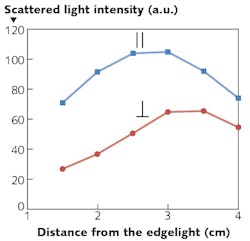Liquid-crystal Displays: Backlight plate for LCDs produces polarized light, boosting efficiency

In a liquid-crystal display (LCD) for a smartphone or other handheld device, the light for the display is usually provided by an edge-lit transparent waveguide plate that contains scattering particles. The light enters the plate and is totally internally reflected across the plate, scattering out of plane toward the viewer (and through the LCD matrix) at a relatively uniform rate across the screen. Because the light source is unpolarized and a conventional waveguide plate is not in itself polarizing, a separate polarizer is placed between the waveguide plate and the viewer to provide the linearly polarized light required for the LCD to operate.
The problem with this approach is that the efficiency of the LCD is cut in half because the polarizing sheet must absorb the other polarization orthogonal to the polarization it passes.
Researchers at the Liquid Crystal Institute, Kent State University (Kent, OH), and BOE Technology Group (Beijing, China) have developed and experimentally tested a waveguide plate that intrinsically produces polarized light by scattering only (or mostly) one polarization towards the viewer. In addition, the unscattered light, which travels to the opposite side of the waveplate because of total internal reflection, could be made to bounce off a reflective quarter-wave plate that rotates the light's polarization by 90° to the orientation that is preferably scattered toward the viewer. In essence, it converts the "wrong" polarization to the "right" polarization, thus boosting the LCD's efficiency beyond what is possible using the conventional approach.
Because the new method does not produce perfectly linearly polarized light (the experimental ratio of orthogonal polarizations is about 2.6 to 1), a conventional polarizing sheet must still also be used. However, in this case, the polarizing sheet absorbs far less light than in a conventional LCD.
Stabilized liquid-crystal
The waveguide plate is in itself a liquid-crystal matrix, but stabilized by a polymer network. It consists of two rubbed glass plates spaced apart by 10 μm, with one of the plates containing an indium tin oxide electrode. The space is filled by a mixture of 92.9% nematic liquid crystal, 6.9% bifunctional monomer, and 0.2% photoinitiator.
In the fabrication process, the setup is first partially polymerized under UV light without a voltage across it, and then completely polymerized while 20 V is placed across it. The first step aligns the molecules in the proper polarization direction (along the rub direction of the plate), while the second step introduces an out-of-plane orientation to the molecules, allowing them to scatter light toward the viewing direction.
Light of the polarization that is not scattered sees a uniform refractive index across the plate, while light having the other polarization sees different refractive indices in different domains and is thus scattered.
The researchers fabricated a 4 x 4 cm polarized light waveguide plate and characterized it first using an unpolarized laser beam as a light source. As a check to see if the plate had fully polymerized, they applied a voltage of 20 V across the thickness of the plate and compared the optical results with those for no voltage (the normal operating state of the plate). The scattering of the plate was mostly the same in both instances, showing full polymerization. Placing a polarizing sheet over the waveguide plate at either parallel or perpendicular polarization allowed the researchers to characterize the plate's polarization properties as a function of distance from the edge light (see figure).
Next, three white LEDs were installed along one edge and their light coupled into the plate. As before, a polarizing sheet was used to characterized the plate's properties. Rotating the sheet from parallel to perpendicular polarization resulted in a change in intensity (in arbitrary units) from 71 to 27, or a ratio of 2.6 to 1.
In both the laser and LED characterization, the intensity of the light emitted by the plate (which was the first prototype) peaked approximately at the middle of the plate. For future iterations, this nonuniformity can be straightforwardly corrected by a better LED arrangement, tailoring of the polymerization process, or both.
REFERENCE
1. A. Moheghi et al., Opt. Mater. Express (2016); doi:10.1364/ome.6.000429.

John Wallace | Senior Technical Editor (1998-2022)
John Wallace was with Laser Focus World for nearly 25 years, retiring in late June 2022. He obtained a bachelor's degree in mechanical engineering and physics at Rutgers University and a master's in optical engineering at the University of Rochester. Before becoming an editor, John worked as an engineer at RCA, Exxon, Eastman Kodak, and GCA Corporation.